Through Beam Reach’s Sustainability portion of the program, we (the students) get to choose projects to either educate the public or volunteer our time. One of the projects we all agreed on and decided we must do is volunteer for SoundWatch. SoundWatch is the boat that follows the orcas around and educates the public about the laws pertaining to them.
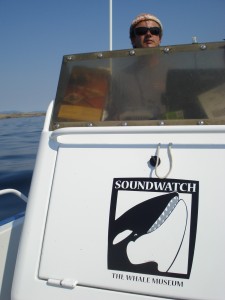
David scoping for whales
All four of us got our own day to volunteer for SoundWatch. I was the third one to go, and I was ecstatic because I had never experienced the orcas from a boat yet! A man named David Howitt picked me up, and we drove to the other side of the Island to Snug Harbor to meet Tyler, another volunteer. After getting my paperwork all squared away, I hopped in the boat with my mustang suite on (these huge orange suites that are very warm PFDs) and we went down to Eagle Point (south of the lighthouse) and found the orcas right away! It was incredibly calm. I was amazed at the amount of fishing boats that were out; I counted 60 from where we were at, and the orcas were right in the middle of them. It was insane! Right away it would’ve already been crazy to try to coax the boaters away from the pod’s path, so we just made sure everyone was stopped so that the orcas could go through. Thankfully they made it out of that mob of vessels safely. Wow, just hearing them breath all around you is breathtaking. It was incredible being out there.
Every half hour it was my job to record where we were (latitude and longitude), how many boats (and types of boats) were present, what the whale’s behavior was, and which pods we were following. Weather was also noted. I was also in charge of giving people a copy of the regulations with this long stick with a little clip. We were lucky, everyone was grateful that we were out there, and treated us well. I guess that doesn’t always happen.
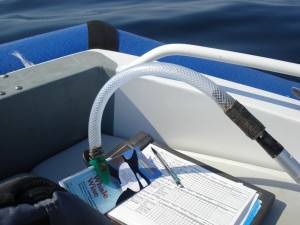
Near the end of the day the whales moved further west, the crowd of boats surrounding them died down. I saw some bull kelp in the water and I thought “I want to try playing one of those…†I’d heard of people being able to play bull kelp, and some even do it to summon the orcas. I’m a music minor, so the idea was hard to pass up! David let me stop for some bull kelp and he cut the end off and made it into a horn! Bull kelp is a long hollow tube that slowly narrows as it gets longer, and it was surprisingly slimy! First David had a go, and being a past horn player himself, I would believe that he could summon the orcas with that sound. Then he let me try, and now I can honestly say I played kelp! Like any brass instrument, I could get a few notes out of the one piece of kelp, and we’d cut it to different sizes to get different sounds.
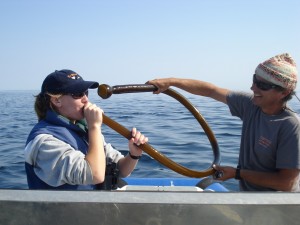
Not long after that there were only about 3 boats left out there. We did our count, and said goodbye to our black and white friends and called it a day.
Read More
My first reaction to the Gato Verde was, “Wow. It’s roomy!†We have it really nice on this French vessel. It was built in 1998 and Captain Todd said the model type hadn’t changed much since it was built, and it felt clean and new. I first looked around the boat, and there are 4 double cabins, and 2 single cabins up in front. The four of us have two double cabins on one of the catamaran’s hulls. The doors are made out of a type of red wood, and the accommodations feel almost hotel-like compared to what I was expecting! My roommate and I share a bed, and again I was amazed at the amount of space we had. I initially imagined being smashed together in a twin size cot. I guess my imagination goes a bit far when they said we’d have tight accommodations! In the middle of the two hulls is the actual cabin, where the kitchen/living room is which consists of a round table with booth-like chairs that also act as storage for our food (that we got the luxury of picking out ourselves instead of going through NOLS). This was our spot during the evenings of entering data that we had gotten throughout the day, or paying catch-up from previous days! After hauling stuff onto the boat, we were off! As we were going to our port, we just explored the boat, and went outside on the “trampoline†which was a mesh that you could sit on and really feel like you were as close to the ocean as you could possibly be without jumping in!
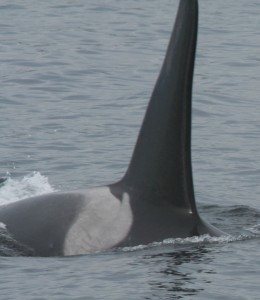
Blackberry!
The very first full day on the boat we got to encounter the whales by salmon bank! So we headed out straight away to go catch them We learned on the fly as we set in the hydrophones and scrambled for data sheets that we’d printed off for our specific projects. It was so amazing: I heard their calls as I heard them come up breathing all around us. Sound travels so brilliantly across the water, you can hear them breathe from pretty far away and still feel like they’re so close. My job was to sit with headphones on until they made calls or clicked and note when it happened, and what type of call it was. The sun was WARM on my back; another luxury I hadn’t planned on having while I was on the boat. We collected data for over three hours! And it felt like 30 minutes. We turned in to Snug Harbor and started looking at the photos at the end of the day. Both Charla and I made the same conclusion: we saw J16 (Slick) and J27 (Blackberry)!
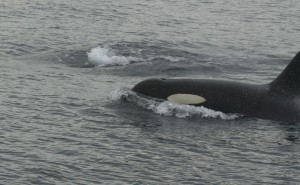
Slick!
We saw whales every day for the first three days of our trip, still learning how to do things on the go. Our first non-whale day was Charla’s birthday, the 23rd, and as close as the trampoline gets you to the water, we decided it wasn’t enough. After a CTD cast, Charla announced, “Okay, we’re jumpin in!” What peer pressure! I can’t say no to such a simple birthday wish, despite my horror to the cold rush that was about to come. But it was such a beautiful warm day! We threw our suits on and it was actually really comfortable out in the sun. And we jumped in! Into 700 feet of water. I felt so small. We swam underneath the Gato, and it was actually quite refreshing after not showering for 5 days.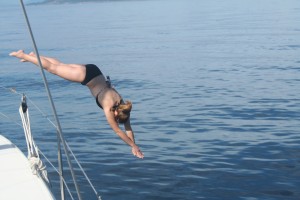
We were locked into Snug Harbor for the majority of the next day due to fog, but when we finally got out, the most incredible thing happened: for the first time of the trip, we got to experience dall’s porpoises riding our bow! We all laid on our bellies at the end of the trampoline and looked over the bow; if I wanted to, I felt like I could reach down and run my hand across one. You could tell that they were just as curious about us as we were about them, because every so often they’d lean far over on their sides and take a look at us. It was a pleasant end to a relatively uneventful day.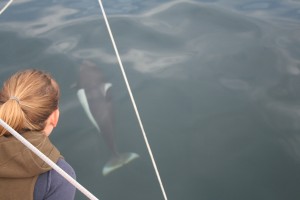
The next couple of days, instead of being trapped by fog, we were trapped by 40 knot winds. We had sailing lessons during this time from Captain Todd (just white-board stuff of course). In the afternoon, we heard the whales were right outside the harbor, and we declared that the wind died down well enough for us to go out and take a peak! For the first time of the trip, all of my rain gear went on and we got to enjoy the whales for about a half hour. I couldn’t deploy the hydrophones unfortunately, because the waves were too high. We went to Garrison Bay for a while because it’s more sheltered than Snug for the winds that weren’t predicted to let up any time soon.
The next day, as predicted, we had 40-knot winds again, and we experienced it right in the harbor! Whales were right in Haro Straight next to us, but we were stuck. By the evening we all went to land and walked for a while at English Camp for some much needed exercise! We also watched Robin’s favorite movie in the world: Life Aquatic.
The next couple of days were data days! We ended up being able to catch the whales right away in the morning! It was great getting back into the groove after a few storm days of storm. I guess we’re really lucky, EVERY day that we’ve had good weather we’ve been able to be with the whales for a while! I think I got some amazing recordings from L pod today, and we’ve been seeing mostly J’s and K’s throughout the week, so this was really exciting for me! I felt like it was like a one-time deal, and the adrenaline kicked in. Such precious data! It was a perfect closing to our first cruise. The final day I went on Soundwatch with Sharon before going back to the labs. Seven Days out of the eleven we got to be with our black and white friends, and I never felt so lucky. 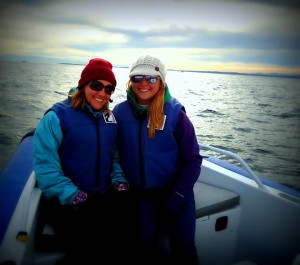
Read More
Throughout my life I’ve always seen a balance with everything. Too much of one thing is not ideal, but not having enough is not ideal either. I was looking for papers to blog about fish sustainability in our oceans, and I found an article that stated right in the abstract that there are two sides to the issue. One side sees universal failure in fisheries management and wants to use protected marine sanctuaries as the ultimate tool to try to rebuild the state of the marine ecosystems around world. This has been done in various locations around the united states with many positive results.
On the other side of the issue are people who are working in fish industries who realize that there have been numerous failures in the management of ocean fishing. But there have also been success stories, and instead of simply making sanctuaries, “This group argues that we need to apply the lessons from the successful fisheries to stop the decline and rebuild those fisheries threatened by excess fishing.â€
Worm et al. stated that if fish stocks keep declining in the same rate as they are now that the world fish stocks will collapse by 2048. With collapsed stocks, diversity of an ecosystem shatters. Worm et al. proposed that the health of a habitat is directly reliant on the diversity that it holds. They set up 32 controlled experiments as well as 12 estuarine experiments to examine the effects of variation of marine diversity of fauna and flora, resource use, and nutrient cycling. They found that increased diversity enhanced all ecosystem processes.
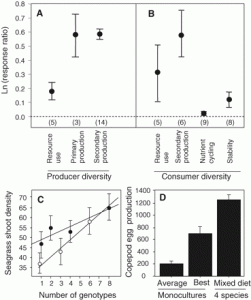
Worm et al. The graphs of Marine biodiversity and ecosystem functioning in controlled experiments.
He found that the more diversity an environment contained, the more capable it was to withstand stress; a factor quite important in these environmentally stressful times.
A proposed explanation was given to explain the advanced recovery at high diverstiy: fishers can switch more readily among target species, and therefore providing overfished species a chance to recover. By restoring biodiversity in the marine habitats through sustainable fisheries, pollution control, and the creation of marine reserves (as stated above), we can reliably invest in what our oceans provide us.
Annoyingly so, I love seafood. When you become a marine biology major, you realize how far we are away from having sustainable fisheries, and it can be quite disgruntling to discover that what you love to eat is not a sustainable food source. But now I carry a seafood watch card in my purse that was released through the Monterey Bay Aquarium.
Here at the Friday Harbor Labs we’ve had some fish for dinner here and there. Most of the selection is Tilapia, and most tilapia comes from fish farms, which is debatably sustainable. Yesterday I was surprised that King Salmon was put on the menu as our main entrée here at the labs. King salmon, also known as Chinook salmon, is considered to be a threatened species in the Puget Sound area. I thought that it was so ironic that a marine science laboratory would have that particular fish on the menu here. Although it’s endangered and threatened in many areas along the Pacific Coast, there are some sustainable practices of Chinook in certain areas, such as wild caught Alaskan salmon. Chinook salmon also happens to be the orca’s favorite type of salmon to eat.
This being said, it is vital for our endangered southern resident killer whales that we do the above suggestions: create marine sanctuaries and create regulations of fishing to maintain diversity and the ecosystem’s ability to handle stress from a rapidly altering environment. There has always been a sense of “freedom of the sea†and the idea of regulations on fish stocks is relatively new. But due to our intense fishing practices, regulations must be installed if we or other creatures depending on fish such as killer whales want to able to fish in the future, especially for the threatened King salmon.
Read More
Have you ever bought something that had a little gold sticker that said “Made in China”? I see that little sticker all over the place! Although it’s not necessarily China, but you get the idea. Of course, all this “Made in (insert country here)” stuff had to have gotten here somehow. We were asked to choose a case study in sustainability science, and the sustainability case study I chose was one about ballast water in ships (like the ships with China’s, or any other country’s, merchandise). Water gets pumped into these ships in order to stabilize it enough to make a safe journey across the oceans. After it gets pumped into ships, it’s then called “ballast water.” What people had often overlooked were the microorganisms residing in this water, such as phytoplankton, zooplankton, and small fish. These organisms get shipped hundreds of miles and get released into an entirely different ecosystem. Often these organisms die out on the journey, but every once and a while there comes a time when a nonlocal organism thrives in their new habitat. These organisms can explode in numbers uncontrollably and can sap the nutrients from the original organisms that reside there. Ballast water is like an ongoing moving infection caused by people in our oceans.
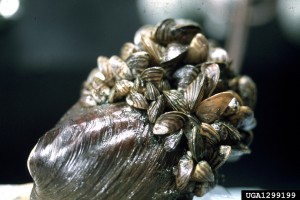
Zebra Mussel
This affects oceans everywhere. Right here in the San Juan Islands there is a bivalve invertebrate Nuttallia obscurata, also known as the purple varnish clam, that came to us through ballast water in the 1980s. The population here varies from quite rare to having up to 700 organisms per square meter. This is not just confined to our oceans; these organisms can spread to our lakes as well. Being from Minnesota, I know about the invasion of zebra mussels. They were believed to have been introduced to the St. Lawrence River in the late 1980’s. These little critters require $500,000,000 per year to control their catastrophic numbers in the Great Lakes alone. They smother local creatures, damage harbors, and need to be cleared regularly from waterways and water treatment plants.
There are different ways to go about this problem. Some have proposed sanitation standards for ballast discharge, which annihilates organisms living in the water. I asked my fellow colleagues in my Beam Reach class how they would go about this problem. Someone suggested that the ballast simply remain in the ship until it returned to its original body of water. Someone else suggested that the ballast should be dumped in the open ocean instead of the harbors. I was very happy with these comments, because they’re thinking right along the lines of John M. Drake, David M. Lodge, and Mark Lewis. They proposed diluting the release of non-indigenous species by limiting the volume of ballast water in a certain location. Spreading organisms reduces the chance of invading sexually reproducing species to flourish and expand. They also argued that the larger an organism is in a species, fewer individuals are required for an invasive blooming population, and simply a filter installed in the ballast release chambers could lower risks of bombardment. They used a reaction-diffusion model and allometric scaling to estimate a safe volume of ballast water that can be released for the smallest maximum for the types of organisms being pumped into the ships.
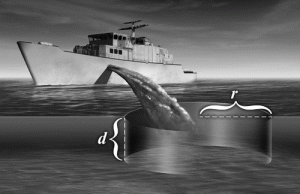 The idea is to create a population of sexually reproducing organisms that is small enough to diffuse until extinction in the area.
The idea is to create a population of sexually reproducing organisms that is small enough to diffuse until extinction in the area.
There is still a great deal of uncertainties that come with this method. Much diffusivity for certain species (or how few organisms is required for the invading species to successfully diffuse) is unknown, and would have to be researched. This method also runs under the assumption that the organisms all sexually reproduce. Dispersal is still very possible over long distances, depending on the species. There is also the foreseen problem that even if a ship were to dump the designated “safe†amount of ballast, precaution would have to be made to make sure that multiple ships weren’t releasing ballast water in the same areas.
The whole idea is to make sure that transported invasive organisms are lost to the population through diffusion faster than they can reproduce. I believe that this offers a simple alternative, and at least a start, to the incredibly impacting problem of fresh and marine habitats. I dislike how their solution doesn’t pertain to non-sexually reproducing fauna and flora, but I appreciate how realistic this temporary solution could be.
So when you buy your “Made in (insert country here)” socks, know that it’s at the cost of marine ecosystems worldwide.
Read More
On the first day of Sustainability Science class, we were asked what exactly sustainability science was. I confidently wrote down in my notebook: “A way to conduct scientific studies that involves little or no disturbance to the surrounding fauna and flora while effectively collecting data usable for quantifiable research.†I pretty much thought that sustainable science was a way of collecting data without disturbing, polluting, or impacting the natural surrounding wildlife. And since we’re using a sailing catamaran, the Gato Verde, that runs on biodiesal and can generate its own power, further confirmed in my mind my definition of sustainability science. After saying this out loud, every other person in the room (including the professors) defined sustainability science through the problems being addressed, such as energy crisis, toxic atmospheres and oceans, and high CO2 levels, and finding a way to combine the sciences into one (sustainability science) to solve these problems. It is the knowledge that ultimately moves toward a place where humans and the environment can coexist comfortably.
Right now I think that’s the obvious definition. But at the time I was thinking about my Deep Sea Conservation class that I had taken at Eckerd College the previous winter term. I distinctly remember an article that my professor had us read, and it was about observing deep-sea fauna next to hydrothermal vents. They noticed that the deep-sea shrimp being observed by the vents with bright lights were actually blinded by the intensity of the lights, and the shrimp by the vents that weren’t exposed to the light showed no signs of disturbance. Physical harm resulted from scientific inquiry. The same goes for trawling in the oceans. Trawling is corrosive and can be detrimental for long periods of time following the trawl. The amount of knowledge obtained by such practices can be seen positively, but such a destructive way to go about research has one wondering whether or not we as scientists are helping or contributing to the problem.
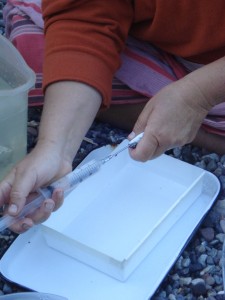
Fig. 1. The semi-invasive of a stomach lavage done on a juvenile Chinook Salmon on Lopez Island, August 27th, 2011.
On the 27th of August, we “Beamers†and Robin just went to Lopez Island to go fishing, and I honestly didn’t know what to expect. Were we catching and releasing? Were we going to just see what we caught and chart the amounts of each species we saw? Were we catching dinner? It turned out that we were actually going to observe the capture of juvenile Chinook salmon. Salmon here is considered a keystone species, meaning that it plays a major role in the entire ecosystem. Here, it’s a major prey item to a wide diversity of creatures, which includes orcas, bears, pinnipeds, and large birds of prey. And hey, people find them tasty as well. With these salmon they performed a stomach lavage, which is pretty much flushing the stomach of its content to see what they prefer to eat.
With Chinook holding an endangered species status, they had to take every precaution to avoid fatalities with the fish. At .5% mortality, I’d say that they’re doing quite well. This practice is considered to be “semi-invasive,†one that I personally believe is worth investigating if it means that we’ll have hard evidence of what is causing these very important fish to struggle as a species, and what would need to be done to help it make a come-back.
Looking at the different definitions of sustainability science that occurred, I must say that perhaps they are all accountable. It is a science that moves us forward to a sustainable planet, and it’s also a science that should be as non-invasive as possible. Analyzing the wide spectrum of invasive practices, as a young scientist, I realize that there is a fine line between conducting strictly non-invasive research, and doing so much research that scientists themselves have an impact on the ecosystems of the planet. It’s a very opinionated topic, and a scientist in these environmentally stressful times must justify how much they’re willing to impact the environment being studied in order to gain the proper amount of knowledge to contribute to a sustainable world.
Read More















 Twitter
Twitter LinkedIn
LinkedIn Facebook
Facebook